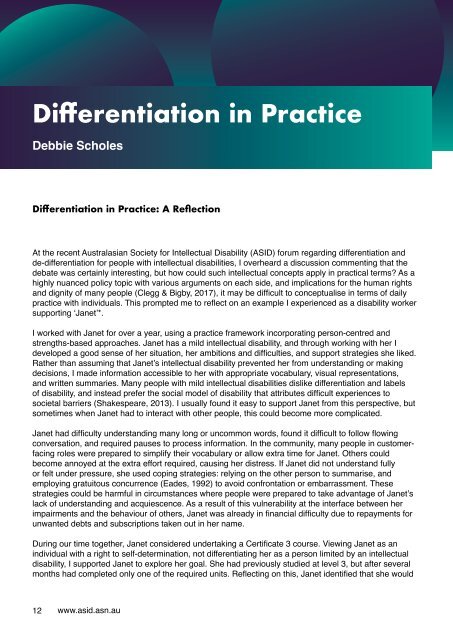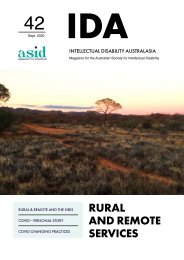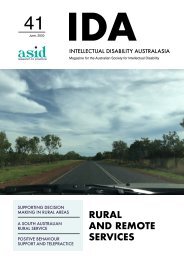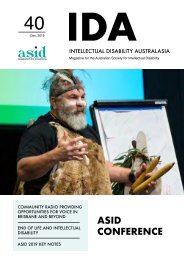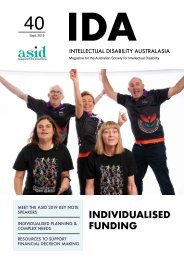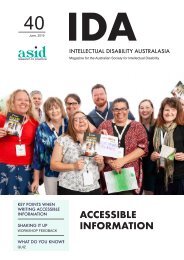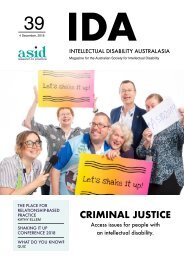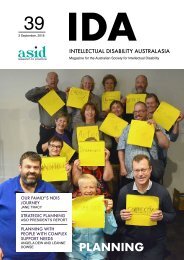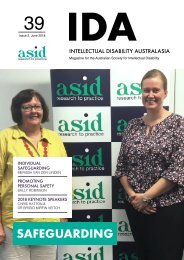IDA Magazine Vol 39 Iss 1 (Mar 2018)
Create successful ePaper yourself
Turn your PDF publications into a flip-book with our unique Google optimized e-Paper software.
Differentiation in Practice<br />
Debbie Scholes<br />
Descriptive Sub-title Descriptive Sub-title Descriptive Sub-title.<br />
Differentiation in Practice: A Reflection<br />
At the recent Australasian Society for Intellectual Disability (ASID) forum regarding differentiation and<br />
de-differentiation for people with intellectual disabilities, I overheard a discussion commenting that the<br />
debate was certainly interesting, but how could such intellectual concepts apply in practical terms? As a<br />
highly nuanced policy topic with various arguments on each side, and implications for the human rights<br />
and dignity of many people (Clegg & Bigby, 2017), it may be difficult to conceptualise in terms of daily<br />
practice with individuals. This prompted me to reflect on an example I experienced as a disability worker<br />
supporting ‘Janet’*.<br />
I worked with Janet for over a year, using a practice framework incorporating person-centred and<br />
strengths-based approaches. Janet has a mild intellectual disability, and through working with her I<br />
developed a good sense of her situation, her ambitions and difficulties, and support strategies she liked.<br />
Rather than assuming that Janet’s intellectual disability prevented her from understanding or making<br />
decisions, I made information accessible to her with appropriate vocabulary, visual representations,<br />
and written summaries. Many people with mild intellectual disabilities dislike differentiation and labels<br />
of disability, and instead prefer the social model of disability that attributes difficult experiences to<br />
societal barriers (Shakespeare, 2013). I usually found it easy to support Janet from this perspective, but<br />
sometimes when Janet had to interact with other people, this could become more complicated.<br />
Janet had difficulty understanding many long or uncommon words, found it difficult to follow flowing<br />
conversation, and required pauses to process information. In the community, many people in customerfacing<br />
roles were prepared to simplify their vocabulary or allow extra time for Janet. Others could<br />
become annoyed at the extra effort required, causing her distress. If Janet did not understand fully<br />
or felt under pressure, she used coping strategies: relying on the other person to summarise, and<br />
employing gratuitous concurrence (Eades, 1992) to avoid confrontation or embarrassment. These<br />
strategies could be harmful in circumstances where people were prepared to take advantage of Janet’s<br />
lack of understanding and acquiescence. As a result of this vulnerability at the interface between her<br />
impairments and the behaviour of others, Janet was already in financial difficulty due to repayments for<br />
unwanted debts and subscriptions taken out in her name.<br />
During our time together, Janet considered undertaking a Certificate 3 course. Viewing Janet as an<br />
individual with a right to self-determination, not differentiating her as a person limited by an intellectual<br />
disability, I supported Janet to explore her goal. She had previously studied at level 3, but after several<br />
months had completed only one of the required units. Reflecting on this, Janet identified that she would<br />
12 www.asid.asn.au


